22.2: Simple mechanism with strong nucleophiles
- Page ID
- 225903
Transesterification
Introduction
When in ester is placed in a large excess of an alcohol along with presence of either an acid or a base there can be an exchange of alkoxy groups. The large excess of alcohol is used to drive the reaction forward. The most common method of transesterification is the reaction of the ester with an alcohol in the presence of an acid catalyst e.g.:

This reaction has the following mechanism:
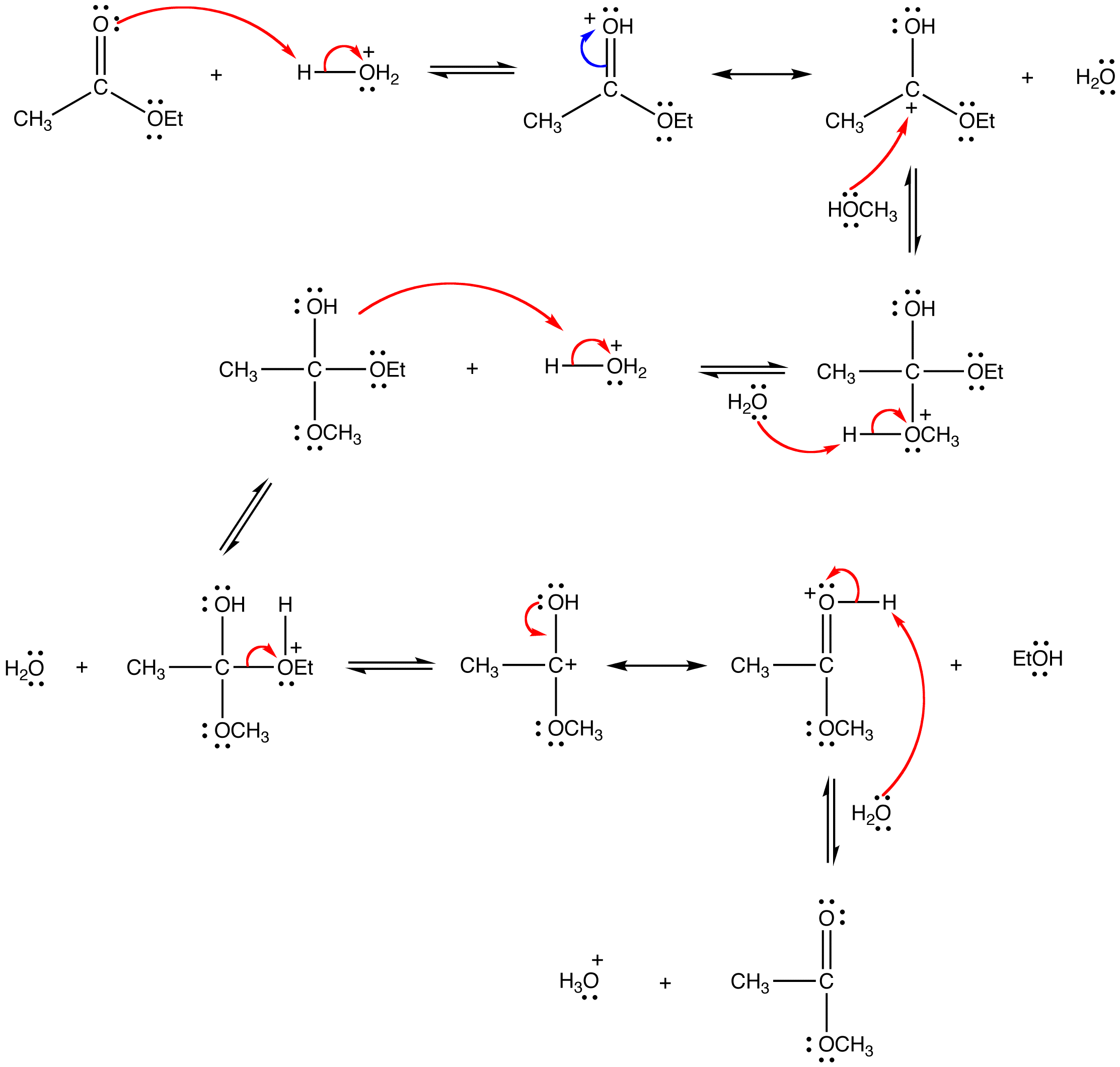
Since both the reactants and the products are an ester and an alcohol, the reaction is reversible and the equilibrium constant is close to one. Consequently, the Le Chatelier’s principle has to be exploited to drive the reaction to completion. The simplest way to do so is to use the alcohol as the solvent as well.
General reaction


Mechanism in basic conditions
Nucleophilic attack by an alkoxide
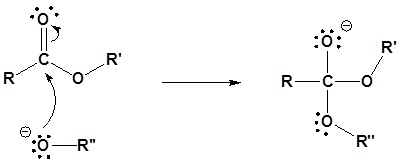
2) Leaving group removal

Contributors
Prof. Steven Farmer (Sonoma State University)
- Gamini Gunawardena from the OChemPal site (Utah Valley University)
Saponification
General reaction

Example

Mechanism
1) Nucleophilic attack by hydroxide

2) Leaving group removal

3) Deprotonation

Contributors
Prof. Steven Farmer (Sonoma State University)
Alkaline hydrolysis of amides
In alkaline hydrolysis the amide is heated with boiling aqueous sodium or potassium hydroxide. The nucleophilic hydroxide ion adds to the carbonyl carbon to form a tetrahedral intermediate, which, with the help of the aqueous solvent, expels the nitrogen as the free amine:

Reduction of carboxylic acids and their derivatives
Reduction of acid chlorides and esters
Acid (acyl) chlorides can be converted to aldehydes using lithium tri-tert-butoxyaluminium hydride (LiAlH(Ot-Bu)3). The hydride source (LiAlH(Ot-Bu)3) is a weaker reducing agent than lithium aluminum hydride. Because acid chlorides are highly activated they still react with the hydride source; however, the formed aldehyde will react slowly, which allows for its isolation.
General reaction:

Example

Acid chlorides can be converted to aldehydes using lithium tri-tert-butoxyaluminium hydride (LiAlH(Ot-Bu)3). The hydride source (LiAlH(Ot-Bu)3) is a weaker reducing agent than lithium aluminum hydride. Because acid chlorides are highly activated they still react with the hydride source; however, the formed aldehyde will react slowly, which allows for its isolation.
General Reaction:

Example

Esters can be converted to aldehydes using diisobutylaluminium hydride (DIBAH). The reaction is usually carried out at -78 oC to prevent reaction with the aldehyde product.

Example

Esters can be converted to 1o alcohols using LiAlH4, while sodium borohydride ($$NaBH_4$$) is not a strong enough reducing agent to perform this reaction.

Example

Mechanism
1) Nucleophilic attack by the hydride

2) Leaving group removal

3) Nucleophilic attack by the hydride anion

4) The alkoxide is protonated

Going from reactant to products simplified

Example

Reduction of amides using LiAlH4.
General Reaction
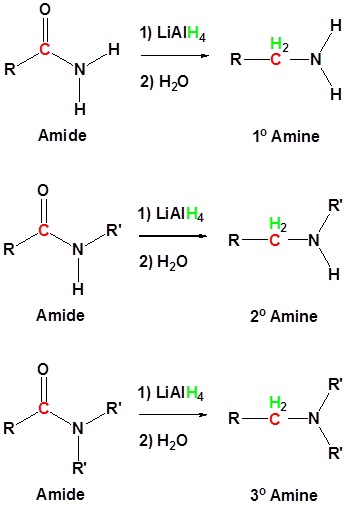
Example: Amide Reduction

Alkyl groups attached to the nitrogen do not affect the reaction.

Mechanism
1) Nucleophilic attack by the hydride
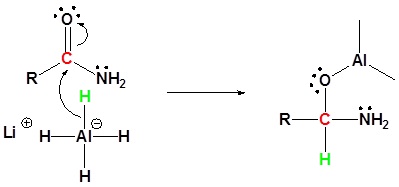
2) Leaving group removal

3) Nucleophilic attack by the hydride
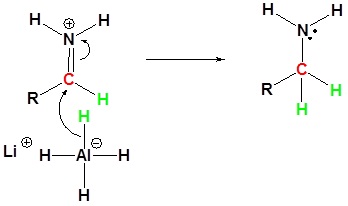
Contributors
- Prof. Steven Farmer (Sonoma State University)
Reduction of acid chlorides and esters using LiAlH4
The mechanism of action of hydride reductions on acid chlorides and esters (carboxyl groups) is similar to that taking place with carbonyl compounds, except that acid chlorides and esters have a leaving group (–Cl and –OR). So the reaction does not stop at formation of the alkoxide ion as a tetrahedral intermediate, but keeps going with an internal nucleophilic displacement of the leaving group. The direct outcome of this process is formation of the corresponding carbonyl compound (aldehyde or ketone), which may or may not undergo further reduction to alcohol, depending on the nature of the reagents used and reaction conditions. The following mechanism illustrates this concept.

For simplicity, only the hydride ion is shown. If a full reactivity reducing agent such as $$LiAlH_4$$ is used, the reaction does not stop at the aldehyde stage, since the carbonyl carbon of the aldehyde can be attacked by another hydride equivalent. This results in formation of the primary alcohol (after hydrolysis of the alkoxide ion) as the final product.

The net reaction then is:

The reaction with an ester is similar, but the leaving group is different (R’O–). Can you draw the mechanism that leads to formation of the products shown?

Notice that with both (and all) carboxyl groups, hydride reductions lead to formation of primary alcohols only. There is no possibility of forming secondary alcohols by this method because the carboxyl group is at the end of the carbon chain, or else the chain gets broken so that the carboxyl carbon ends up at the end of a chain in the final product.
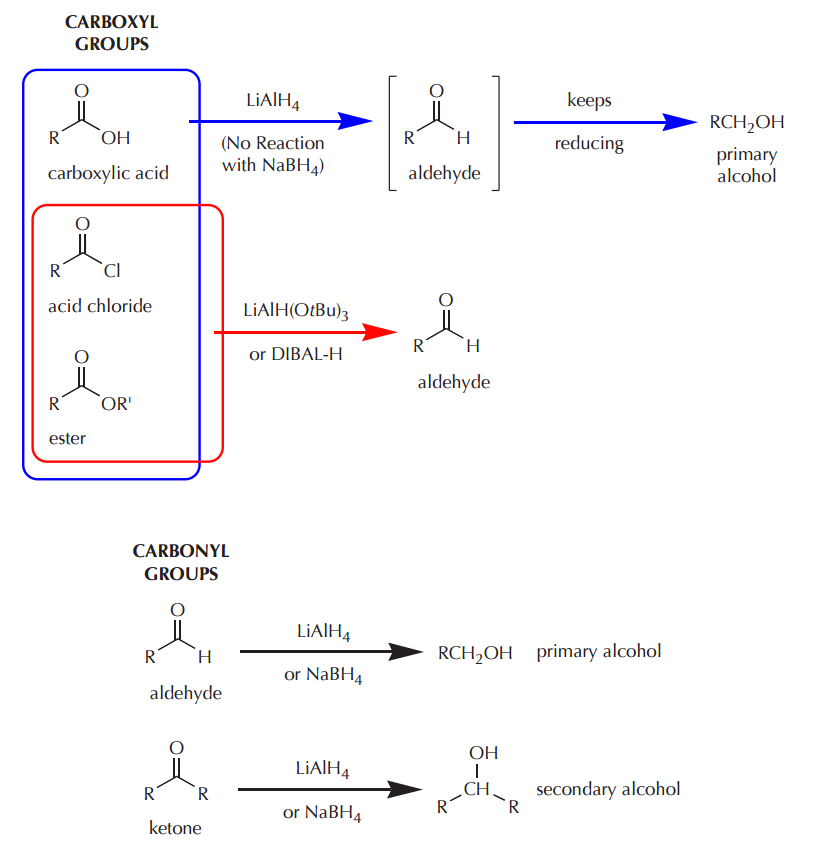
Nucleophilic acyl substitution reactions of carboxylic acids
Acid anhydride formation
An acid anhydride (or just anhydride) is the product of formal condensation of two oxoacid molecules with the release of a water molecule. The most common anhydrides in organic chemistry are those derived from carboxylic acids at high temperatures to remove water.

Carboxylic acids react with thionyl Chloride ($$SOCl_2$$) to form acid chlorides
During the reaction the hydroxyl group of the carboxylic acid is converted to a chlorosulfite intermediate making it a better leaving group. The chloride anion produced during the reaction acts a nucleophile.

Example

Mechanism
1) Nucleophilic attack on Thionyl Chloride

2) Removal of Cl leaving group

3) Nucleophilic attack on the carbonyl

4) Leaving group removal

5) Deprotonation

Conversion of carboxylic acids to amides
The direct reaction of a carboxylic acid with an amine would be expected to be difficult because the basic amine would deprotonate the carboxylic acid to form a highly unreactive carboxylate. However when the ammonium carboxylate salt is heated to a temperature above 100 oC water is driven off and an amide is formed.
General Reaction

Going from reactants to products simply

Conversion of carboxylic acids to amide using DCC as an activating agent
The direct conversion of a carboxylic acid to an amide is difficult because amines are basic and tend to convert carboxylic acids to their highly unreactive carboxylates. In this reaction the carboxylic acid adds to the DCC molecule to form a good leaving group which can then be displaced by an amine during nucleophilic substitution. DCC induced coupling to form an amide linkage is an important reaction in the synthesis of peptides.
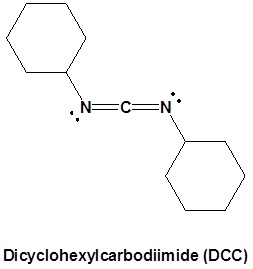
Basic reaction

Going from reactants to products simplified

Mechanism
1) Deprotonation

2) Nucleophilic attack by the carboxylate
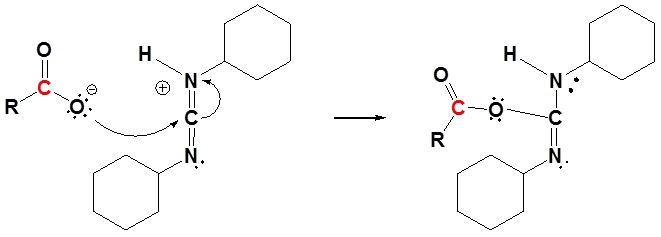
3) Nucleophilic attack by the amine
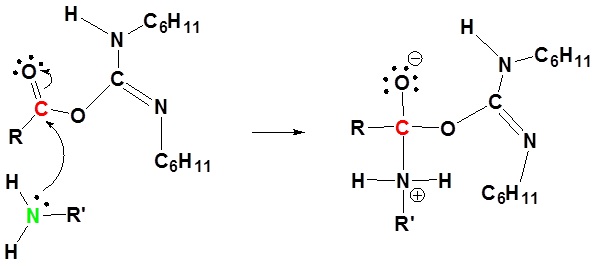
4) Proton transfer

5) Leaving group removal
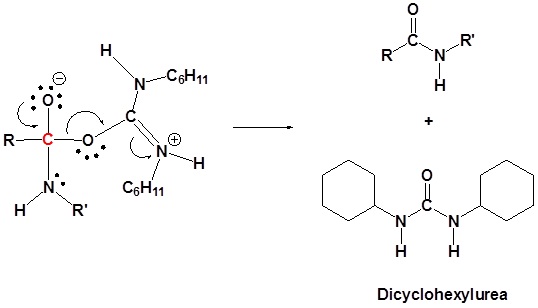
Chemistry of Amides
Preparation of amides
Nitriles can be converted to amides. This reaction can be acid or base catalyzed

Carboxylic acid can be converted to amides by using DCC as an activating agent

Direct conversion of a carboxylic acid to an amide by reaction with an amine.

Acid chlorides react with ammonia, 1o amines and 2o amines to form amides

Acid anhydrides react with ammonia, 1o amines and 2o amines to form amides

Conversion of amides into carboxylic acids: Hydrolysis
This page describes the hydrolysis of amides under both acidic and alkaline conditions. It also describes the use of alkaline hydrolysis in testing for amides.
What is hydrolysis?
Technically, hydrolysis is a reaction with water. That is exactly what happens when amides are hydrolyzed in the presence of dilute acids such as dilute hydrochloric acid. The acid acts as a catalyst for the reaction between the amide and water. The alkaline hydrolysis of amides actually involves reaction with hydroxide ions, but the result is similar enough that it is still classed as hydrolysis.
Hydrolysis under acidic conditions
Taking ethanamide as a typical amide. If ethanamide is heated with a dilute acid (such as dilute hydrochloric acid), ethanoic acid is formed together with ammonium ions. So, if you were using hydrochloric acid, the final solution would contain ammonium chloride and ethanoic acid.
\[ CH_3CONH_2 + H_2O + HCl \ rightarrow CH_3COOH + NH_4^+Cl^-\]
Hydrolysis under alkaline conditions
Also, if ethanamide is heated with sodium hydroxide solution, ammonia gas is given off and you are left with a solution containing sodium ethanoate.
\[ CH_3CONH_2 + NaOH \ rightarrow CH_3COONa + NH_3\]
Conversion of amides into amines: Reduction
Amides can be converted to 1°, 2° or 3° amines using LiAlH4.
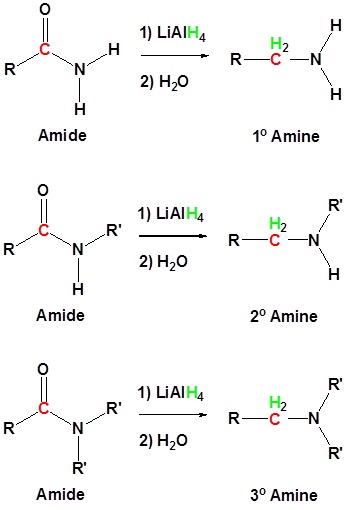
Examples
Amide Reductions

Alkyl groups attached to the nitrogen do not affect the reaction.

Contributors
- Dr. Dietmar Kennepohl FCIC (Professor of Chemistry, Athabasca University)
- Prof. Steven Farmer (Sonoma State University)
- Jim Clark (Chemguide.co.uk)
Grignard reagents convert esters into tertiary alcohols
General Reaction

Examples

Contributors
Prof. Steven Farmer (Sonoma State University)
Claisen condensation
 This is referred to as a Claisen condensation, after the German chemist Ludwig Claisen (1851-1930).
This is referred to as a Claisen condensation, after the German chemist Ludwig Claisen (1851-1930). Basic reaction

Going from reactants to products simply 
Example: Claisen Condensation


Claisen condensation mechanism
1) Enolate formation

2) Nucleophilic attack
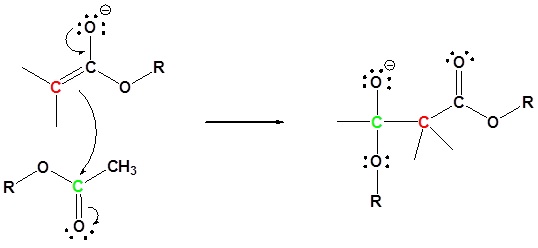
3) Removal of leaving group

Dieckmann Condensation
A diester can undergo an intramolecular reaction called a Dieckmann condensation.
Example: Dieckman Condensation

Crossed Claisen condensation
Claisen condensations between different ester reactants are called CrossedClaisen reactions. Crossed Claisen reactions in which both reactants can serve as donors and acceptors generally give complex mixtures. Because of this most Crossed Claisen reactions are usually not performed unless one reactant has no alpha hydrogens.
Example : Crossed Claisen Condensation

Contributors
- Prof. Steven Farmer (Sonoma State University)
- Transesterification. Authored by: Prof. Steven Farmer and Gamini Gunawardena. Located at: https://chem.libretexts.org/Textbook_Maps/Organic_Chemistry/Supplemental_Modules_(Organic_Chemistry)/Esters/Reactivity_of_Esters/Transesterification. Project: Chemistry LibreTexts. License: CC BY-NC-SA: Attribution-NonCommercial-ShareAlike
- Saponification. Authored by: Prof. Steve Farmer. Located at: https://chem.libretexts.org/Textbook_Maps/Organic_Chemistry/Supplemental_Modules_(Organic_Chemistry)/Esters/Reactivity_of_Esters/Saponification. Project: Chemistry LibreTexts. License: CC BY-NC-SA: Attribution-NonCommercial-ShareAlike
- Organic Chemistry With a Biological Emphasis. Authored by: u00a0Tim Soderberg. Located at: https://chem.libretexts.org/Textbook_Maps/Organic_Chemistry/Book%3A_Organic_Chemistry_with_a_Biological_Emphasis_(Soderberg). Project: Chemistry LibreText. License: CC BY-NC-SA: Attribution-NonCommercial-ShareAlike

